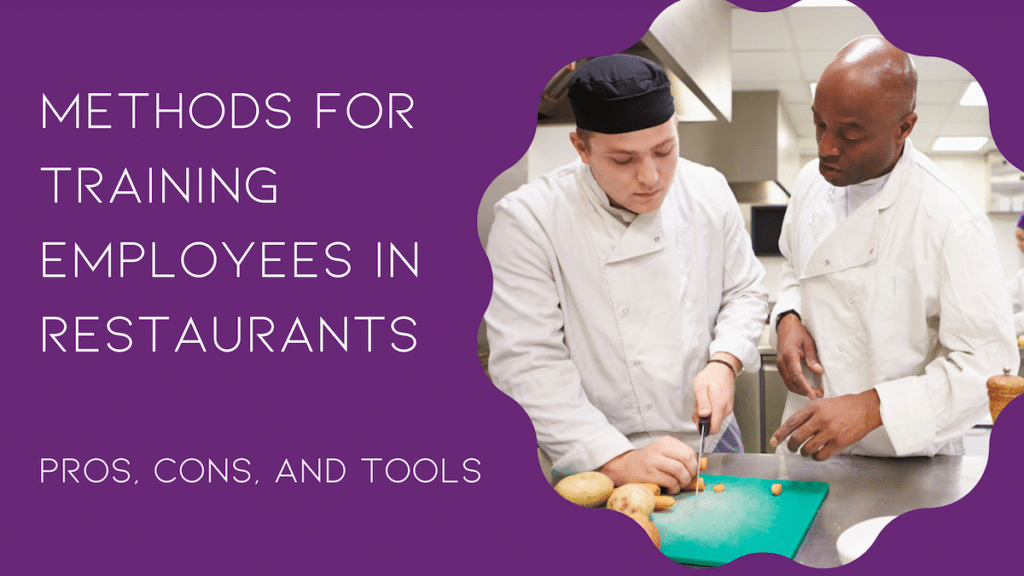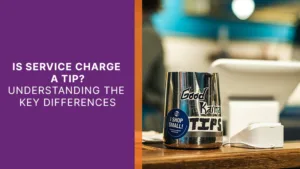Updated on: February 3, 2025
Understanding how to best train new employees (and provide ongoing training to those with longer tenure) can feel like an endless buffet in the restaurant industry. It’s hard to know what comprehensive training programs, hands-on training, and house training methods to choose and what will be best for your employees. But the good news about restaurant training is that just like building your menu, you can make your own training mix for best impact for your customers and your entire team. There are many methods for training restaurant employees, and what will work best for your employees is up to you.

Methods for Training Employees in Restaurants
First things first, what kinds of training should you consider? While there are a virtually endless combinations of training styles, here are some of the most common methodologies for maximizing knowledge retention, improving or teaching technical skills, and enhancing the guest experience:
1. On-the-Job Training
Just as it sounds, this is when you assign a new employee to shadow a current employee and learn by observation and experience. This involves providing new employees with hands-on experience while they are working, under the supervision of an experienced employee or manager. This can be an effective way to introduce new employees to the job and give them the opportunity to learn by doing. This is also a great chance for new hires to pick the brains of seasoned employees for helpful tips and tricks.
There are several pros and cons for restaurant managers to consider when it comes to on-the-job training in restaurants:
Pros of on-the-job training:
- On-the-job training can be an effective way to introduce new employees to the job and give them the opportunity to learn by doing.
- It allows new employees to get a feel for and be immersed in the restaurant’s culture and learn about the expectations for their job. Restaurant staff training will teach new employees the soft skills of the hospitality industry while establishing the importance of high standards and adherence to food safety training.
- On-the-job training can be more cost-effective than other types of training, as it doesn’t require the use of specialized training facilities or materials.
- It allows new employees to get immediate feedback from experienced staff on their performance and make adjustments as needed. Learning to adjust in fast-paced environments can prove effective in enriching team communication and product knowledge.
- In-person training helps the material stick particularly well, making the training process an empowering and enjoyable one for your house team, possibly minimizing turnover rates and making use of the training period.
Cons of on-the-job training:
- On-the-job training can be time-consuming, as it requires an experienced employee or manager to be present to provide guidance and supervision.
- It may not provide new employees with as much structure or support as other types of training, such as classroom training or online training programs.
- If on-the-job training is not well-organized, new employees may not receive a thorough or consistent training experience.
- It can be challenging for new employees to learn complex details such as menu knowledge or the intricacies of excellent customer service while also trying to keep up with the demands of the job.
- On-the-job training is hard to duplicate and make consistent, especially when training employees across many locations. If you rely solely on this type of training, then the level of training of each employee will vary widely. A lack of materials to reference, like training videos or a digital training manual, may not work well for different learners.
2. Self-Guided Reference Materials
This type of training allows employees to learn on their own and go back to reference the training materials whenever they need a refresher. Self-guided reference materials are written guides or resources that employees can refer to as they learn the job. A good example of this is your restaurant training manual. Physical or digital tools set employees up for success with a training plan they can rely on as they take in all of the many aspects of the dining experience.
Here are some pros and cons to consider when it comes to self-guided reference materials for restaurant training:
Pros of self-guided training methods:
- Self-guided reference materials can be a convenient and flexible way for employees to learn at their own pace.
- They can be useful for employees who prefer to learn independently or who may have busy schedules that don’t allow for structured training sessions. It also allows for at-home training between in-restaurant training sessions.
- Self-guided reference materials can be a cost-effective way to provide training, as they do not require the use of training facilities, materials, or personnel.
- They can be easily updated and revised to ensure that employees are receiving the most current information.
- Self-guided training takes advantage of materials that can be consistent across all your employees and locations, helping to standardize your training approach.
Cons of self-guided training methods:
- Self-guided reference materials may not be as effective for some employees as more interactive forms of training, such as classroom training or on-the-job training.
- It can be challenging for employees to ask questions or get clarification on certain points if they are learning independently.
- It inherently contains a lack of feedback from the trainee, so you can’t be sure if they are understanding or covering all the required material.
- Some employees may find self-guided reference materials to be less engaging or less motivating than other types of training.
- If the reference materials are not well-written or organized, they may be difficult for employees to understand or use effectively.
3. Elearning and Online Training
Many restaurants now offer online training programs that new employees can complete at their own pace. This can be a convenient and cost-effective way to provide training, especially if employees are scattered across different locations. When you’re managing training across an entire chain of restaurants, online training can be a great way to standardize your training practices.
There are several pros and cons to consider when it comes to online training for restaurant employees:
Pros of eLearning and online training:
- Online training is convenient, as it allows employees to complete the training at their own pace and from any location with an internet connection.
- It can be cost-effective, as it eliminates the need for specialized training facilities or materials.
- Online training programs can be easily updated, ensuring that employees are receiving the most current information.
Cons of eLearning and online training:
- Online training may not be as effective for some employees as hands-on, in-person training.
- It can be difficult for employees to ask questions or get clarification on certain points if they are completing the training independently.
- Some employees may be less motivated to complete online training, as they may not have the same level of accountability as they would in a traditional training setting.
- If the online training program is not well-designed or engaging, employees may not retain as much of the information as they would in a more interactive training environment.
- Online training doesn’t provide interaction with the people that the new employee will be rubbing shoulders with. As important as the tasks an employee is required to complete is how that employee will work alongside their coworkers.

4. Instructor-led training
Instructor-led training, also known as classroom training, involves providing new employees with instruction in a more formal setting, such as a classroom or conference room, or even a kitchen. Here are some pros and cons to consider when it comes to instructor-led training for restaurant employees:
Pros of instructor-led training:
- Instructor-led training can be an effective way to provide new employees with a thorough overview of the restaurant’s policies, procedures, and systems.
- It allows for a more interactive learning experience, as employees can ask questions and clarify any misunderstandings in real-time.
- Instructor-led training can be more engaging for some employees, as it allows for a more interactive learning experience.
- It can be a good way to build a sense of team cohesion, as all employees are learning together in the same setting.
Cons of instructor-led training:
- Instructor-led training can be more time-consuming and costly than other types of training, as it requires the use of specialized training facilities and materials.
- Instructor-led training is limited to a physical location, and can be difficult to organize and manage when training employees in multiple locations. To keep training consistent, each instructor will also need their own training on how to properly teach new hires.
- It may not be as flexible as other types of training, as it requires employees to be present at a specific time and location.
- Some employees may find classroom-style training to be less engaging or less effective than other types of training.
- It can be challenging to accommodate the learning styles and needs of all employees in a group setting.
5. Gamification
Regardless of how it’s delivered, gamified training uses the principles of gaming to motivate and incentivize employee interaction and information retention. Gamification is the process of adding game-like elements to non-game activities in order to make them more engaging and enjoyable. It may not seem like a restaurant is a place where gamification can really be applied, but there are some ways of making it work. Here are some examples of how your training could be gamified:
- Use points, badges, or other rewards to motivate employees to complete training tasks or modules.
- For training a large number of employees across many locations, it can be fun to create a leaderboard or competition to encourage employees to compete with each other to see who can complete the training the fastest or score the highest on quizzes or tests.
- Incorporate interactive elements, such as puzzles, quizzes, or mini-games, into the training program to make it more engaging and fun.
- Allow employees to customize their training experience by letting them choose their own avatar in your online training system, or allowing them to select their own training path, choosing topics in an order they would prefer rather than a rigid training schedule.
Gamification can definitely add a little more character and personality to your training programs, and if your restaurant culture is a little more fun and interactive, it can be a cool way to introduce that to new employees. There are definitely some pros to this style, but there are cons to consider as well.
Here are some pros and cons of gamification in restaurant employee training:
Pros of gamification in training:
- Gamification can make training more engaging and enjoyable for employees, which can lead to better retention of the material and improved performance on the job.
- It can be a useful way to motivate employees to complete training tasks or modules and encourage them to learn more.
- It can be a powerful tool for introducing the culture of your restaurant business, especially if your goal is to be a fun, upbeat, and modern place to work. A positive and enjoyable workplace is key to employee retention and happy customers.
- Gamification can add a sense of fun and competition to training, which can be especially useful for employees who may not be as motivated to learn in a traditional training setting.
- It allows for a more interactive and immersive learning experience, which can be more effective for some employees.
Cons of gamification in training:
- Gamification may not be suitable for all types of training or all employees. Some employees may not be interested in game-like elements and may prefer a more traditional training approach.
- Gamification, while fun, can also mean rushing through certain training tasks. In a kitchen setting, this can even be dangerous and lead to serious accidents.
- Gamification can be time-consuming and costly to implement, as it requires the development of game-like elements and resources.
- It may not be as effective for employees who prefer a more structured or serious learning environment.
- If the gamification elements are not well-designed or engaging, it could have the opposite effect and make the training less enjoyable for employees.
6. Microlearning
Like gamification, microlearning is a format independent of how it’s delivered. The goal is to help avoid cognitive overload by breaking up the training into small pieces that are easy to understand and absorb. In a restaurant, this may be best utilized when walking through an entire process, like how to organize ingredients in a proper order or what steps to taking when opening or closing the restaurant, and repeating each step individually before tackling the process as a whole.
Here are some pros and cons to consider when it comes to microlearning in restaurant training:
Pros of microlearning in training:
- Microlearning can be an effective way to break complex concepts down into manageable pieces, making it easier for employees to learn and understand them.
- It allows for a more flexible and convenient learning experience, as employees can complete the training in small chunks as their schedule allows.
- Microlearning can be more engaging for some employees, as it provides a sense of accomplishment and progress as they complete each small learning unit.
- It can be an effective way to provide just-in-time training, as employees can access the information they need when they need it.
Cons of microlearning in training:
- Microlearning may not be as effective for some employees as more comprehensive, in-depth training approaches.
- It can be challenging to ensure that all of the necessary information is covered in the small learning units.
- If each microlearning piece isn’t properly connected to the process or concept as a whole, the training can be disjointed and the understanding of the bigger picture can be lost.
- Microlearning may be less suitable for complex or nuanced concepts that require a deeper understanding or more context.
- It can be time-consuming to develop and maintain a microlearning program, as it requires the creation of many small learning units.

What do we think is the best restaurant training methodology to use?
In an ideal world, employee training would be a combination of methodologies. There’s no substitute for on-the-job training shadowing other employees, but it’s time intensive and doesn’t allow the new employee to review what they learned very well.
That’s where things like one-page reference sheets and videos of specific processes come in to fill in the gaps. It gives your team something to reference when they’re feeling unsure, without the resource strain of pulling a more experienced employee away from whatever they are doing. Those kinds of microlearning assets are also great reinforcement when employee shadowing leads to information overload.
If you have a budget that allows you to outsource training or a stellar internal training team, gamification can be a great addition to more traditional methods, but developing a gamified training can be a resource hog. See how Domino’s used gamification to get new employees up-to-speed and accurate more quickly.
Restaurant Training Tools for Implementing the Right Methods for Training Employees
When considering what training methods you’ll use for your training mix, you will also need to consider what tools might be needed or best-suited for your methods. There are lots of different formats and tools available. These include:
- Training manuals: These are written guides that outline the policies, procedures, and systems of the restaurant. Training manuals can be useful for providing new employees with a reference they can refer to as they learn the job.
- Checklists: Checklists can be used to help new employees keep track of the tasks they need to complete and ensure that they are following the correct procedures. In our minds, checklists are vital to making sure that each employee gets through every part of the training, and that nothing is missed. Checklists are also a great way to organize microlearning methods, or as a quick-reference resource when on-the-job training.
- Role-playing exercises: These involve having employees practice their customer service skills by pretending to be a customer or server in a simulated restaurant setting.
- Video training: Many restaurants use video training programs to teach new employees about the restaurant’s policies, procedures, and systems. These can be especially useful for demonstrating tasks that are difficult to describe in writing, and are usable resources for training across multiple locations in a consistent and standardized way.
- Simulation software: Some restaurants use simulation software to help new employees learn about the restaurant’s operations and systems. This can be a useful tool for providing hands-on experience in a controlled environment. This is most useful when a restaurant chain has many locations that are all designed and operate in a similar way.
- Group training sessions: These involve bringing new employees together for a training session with an experienced employee or manager. These can be an effective way to provide group instruction and allow new employees to ask questions and clarify any misunderstandings.
One of the most important training tools: Restaurant HR Software
In today’s culture, and when working within a restaurant enterprise with many locations, you can save yourself a lot of time and effort by utilizing a digital version through restaurant HR software. This software can be incredibly useful for keeping updated versions of your manuals, videos, and other resources in a place that can be accessed and referenced from anywhere and at any time.
Not only that, but restaurant HR software can also help you create onboarding and training documents and checklists that will ensure that each employee is up-to-date on their training, and that no important topics are missed. This can be especially useful when you are managing the training of new employees across a large number of locations, saving your HR department a lot of time and energy in tracking the progress of each new employee.
Additional Topics for Your Restaurant Training Program
Your restaurant training program will likely cover a wide range of topics, and can be implemented in just as many ways. Check out more of our training program resources to make the most of your restaurant training program:
- Creating a Restaurant Training Manual
- Restaurant Employee Onboarding: How-to and Common Topics
- Role-Specific Restaurant Training in Quick-Service and Fast Casual Restaurants
- Continuing Restaurant Training After Onboarding
- Additional Training Topics for Restaurant Employees






